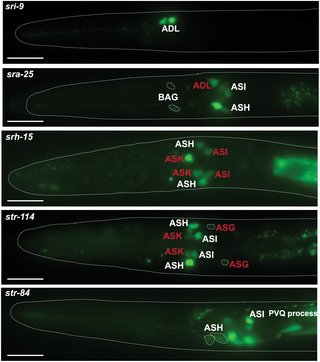PLOS Biology ( IF 9.8 ) Pub Date : 2018-01-02 , DOI: 10.1371/journal.pbio.2004218 Berta Vidal , Ulkar Aghayeva , Haosheng Sun , Chen Wang , Lori Glenwinkel , Emily A. Bayer , Oliver Hobert

|
One goal of modern day neuroscience is the establishment of molecular maps that assign unique features to individual neuron types. Such maps provide important starting points for neuron classification, for functional analysis, and for developmental studies aimed at defining the molecular mechanisms of neuron identity acquisition and neuron identity diversification. In this resource paper, we describe a nervous system-wide map of the potential expression sites of 244 members of the largest gene family in the C. elegans genome, rhodopsin-like (class A) G-protein-coupled receptor (GPCR) chemoreceptors, using classic gfp reporter gene technology. We cover representatives of all sequence families of chemoreceptor GPCRs, some of which were previously entirely uncharacterized. Most reporters are expressed in a very restricted number of cells, often just in single cells. We assign GPCR reporter expression to all but two of the 37 sensory neuron classes of the sex-shared, core nervous system. Some sensory neurons express a very small number of receptors, while others, particularly nociceptive neurons, coexpress several dozen GPCR reporter genes. GPCR reporters are also expressed in a wide range of inter- and motorneurons, as well as non-neuronal cells, suggesting that GPCRs may constitute receptors not just for environmental signals, but also for internal cues. We observe only one notable, frequent association of coexpression patterns, namely in one nociceptive amphid (ASH) and two nociceptive phasmid sensory neurons (PHA, PHB). We identified GPCRs with sexually dimorphic expression and several GPCR reporters that are expressed in a left/right asymmetric manner. We identified a substantial degree of GPCR expression plasticity; particularly in the context of the environmentally-induced dauer diapause stage when one third of all tested GPCRs alter the cellular specificity of their expression within and outside the nervous system. Intriguingly, in a number of cases, the dauer-specific alterations of GPCR reporter expression in specific neuron classes are maintained during postdauer life and in some case new patterns are induced post-dauer, demonstrating that GPCR gene expression may serve as traits of life history. Taken together, our resource provides an entry point for functional studies and also offers a host of molecular markers for studying molecular patterning and plasticity of the nervous system.
中文翻译:

秀丽隐杆线虫化学感受器表达图谱
现代神经科学的一个目标是建立分子图谱,为各个神经元类型赋予独特的功能。此类图谱为神经元分类,功能分析以及旨在定义神经元身份获取和神经元身份多样化的分子机制的发育研究提供了重要的起点。在此资源文件中,我们描述了C中最大基因家族的244个成员的潜在表达位点的全神经系统图。线虫基因组,视紫红质样(A类)G蛋白偶联受体(GPCR)化学受体,使用经典gfp记者基因技术。我们涵盖了化学感受器GPCR的所有序列家族的代表,其中一些以前完全没有特征。大多数报道分子在非常有限的细胞中表达,通常仅在单个细胞中表达。我们将GPCR报告基因表达分配给性别共有的核心神经系统的37个感觉神经元类别中的两个类别。一些感觉神经元表达非常少的受体,而其他一些,特别是伤害性神经元,共表达数十个GPCR报告基因。GPCR报告基因还表达于广泛的间神经元和运动神经元以及非神经元细胞中,这表明GPCR不仅可以构成环境信号的受体,而且还可以构成内部线索的受体。我们仅观察到一种常见的共表达模式关联,即在一个伤害感受性两性(ASH)和两个伤害感受态的粘粒感觉神经元(PHA,PHB)中。我们鉴定出具有性双态表达的GPCR和以左/右不对称方式表达的几个GPCR报告基因。我们确定了很大程度上的GPCR表达可塑性。特别是在环境诱导的道尔滞育阶段,所有测试的GPCR中有三分之一会改变其在神经系统内外的表达的细胞特异性。有趣的是,在许多情况下,特定的神经元类别中GPCR报告子表达的dauer特异性改变在dauauer寿命期间得以维持,并且在某些情况下,在dauer以后会诱导新的模式,表明GPCR基因表达可能是生活史的特征。 。在一起


























 京公网安备 11010802027423号
京公网安备 11010802027423号